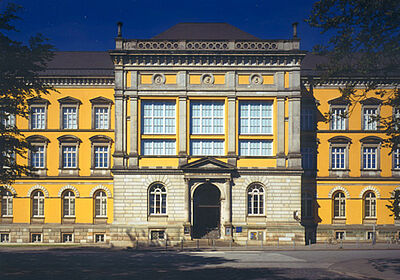A16 Museum meets Management

Having experienced the change from the perspective of a scientific volunteer was of great profit.
First of all, the institution also received an extension, erected in the courtyard of the museum and named after its founder Otto Schümann. It was especially planned for the collection of historical keyboard instruments from Prof. Andreas Beurmann who compiled a list of no less than 600 instruments with the intention to make them accessible in playable condition. To keep such a number of instruments constantly in tuned condition would also be an unmanageable task een for a piano factory - besides the associated conservation problems.
At the same time, the institution also underwent the transformation into a foundation under public law, so that massive restructuring came in sight - with a significant impact on the required qualifications of employees who educated themselves from now on more in the fields of business administration, project and event management or museum education. The classical education for a custos was henceforth no longer suitable for the future.
Protected monument and code of Ethics oriented scientists saw this development with great concern. The conflict of goals was inevitable. The more I'm indebted to Prof. Wilhelm Hornbostel, the former director of the institution, because he informed me immediately about the fact that any hope to be taken over as a custos of the instrument collection was definitely ruled out after the traineeship.
The consequences of this decision did not require further consideration: I broke off the internship, completed an executive program for project and product managers and wrote my thesis entitled: "The 'labor market' for art historians: Causes measures solutions. Because such procedures were not to change, it became at least important to analyze the conditions.
The 1998 Neil and Philip Kotler published their study: Museum Strategy and Marketing, which describes the requirements that became from now on also relevant for European museums. In their time of origin, the nation-state prestige usually played a big role, closely followed by the function as educational institution. Today, the same institutions are in competition with leisure providers of all kinds and so they behave on the market in accordance with them. This is the reason why fundraising plays an increasingly important role. It is understood that such tasks demand a specific qualification and lead away from pure research.
To summarize in a short confrontation: In the interest of the increase of knowledge about the past, the focus was on conservation, research and dissemination. With the publication of museum catalogs, technical articles and books this task has been fulfilled.
In case the interest of the target group (society) decreases, the museums remain empty - as there is no equivalent to compulsory education - and it requires special efforts to regain the attractiveness and appreciation in a different way. Not for nothing the above-mentioned Authors put on top of their preface the statement: "The Museum can reach only those whom it can attract". With visitor counters in every room, the efficiency of individual activities can be read directly.

